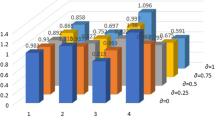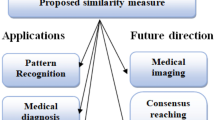Abstract
Bipolar complex fuzzy soft sets, one of the substantial notions, generalize the notions of bipolar complex fuzzy sets and soft sets. The notion of bipolar complex fuzzy soft sets is a significant tool to cope with the awkward and complicated information involving the second dimension, i.e., unreal part, both positive and negative opinions, and the parameters. Further, similarity measures play an important role in various fields such as data mining, machine learning, information retrieval, and natural language processing. They are used to measure the degree of similarity or dissimilarity between two or more objects, documents, images, or any other type of data. Consequently, in this script, we diagnose trigonometric similarity measures like generalized cosine similarity measure, generalized tangent similarity measure and generalized cotangent similarity measure, and generalized hybrid trigonometric similarity measure in the environment of bipolar complex fuzzy soft sets. Furthermore, we also discuss the weighted generalized cosine similarity measure, weighted generalized tangent similarity measure, weighted generalized cotangent similarity measure, and weighted generalized hybrid trigonometric similarity measure for bipolar complex fuzzy soft sets. After that, through the diagnosed similarity measures, we analyze real-life dilemmas like pattern recognition and medical diagnosis to portray the applicability and benefits of the diagnosed similarity measures in the real world. At the end of this study, we show the superiority and supremacy of the analyzed trigonometric similarity measures by doing their analysis with certain prevailing similarity measures.




Similar content being viewed by others
Data availability
The data utilized in this manuscript are hypothetical and artificial, and one can use these data before prior permission by just citing this manuscript.
References
Abdullah S, Aslam M, Ullah K (2014) Bipolar fuzzy soft sets and its applications in decision making problem. J Intell Fuzzy Syst 27(2):729–742
Abid MN, Yang MS, Karamti H, Ullah K, Pamucar D (2022) Similarity measures based on T-spherical fuzzy information with applications to pattern recognition and decision making. Symmetry 14(2):410
Adam F, Hassan N (2014) Q-fuzzy soft set. Appl Math Sci 8(174):8689–8695
Ahmmad J, Mahmood T, Chinram R, Iampan A (2021) Some average aggregation operators based on spherical fuzzy soft sets and their applications in multi-criteria decision making. AIMS Math 6(7):7798–7833
Akram M, Akmal R (2016) Application of bipolar fuzzy sets in graph structures. Appl Comput Intell Soft Computng
Akram M, Arshad M (2020) Bipolar fuzzy TOPSIS and bipolar fuzzy ELECTRE-I methods to diagnosis. Comput Appl Math 39(1):1–21
Akram M, Waseem N (2018) Novel applications of bipolar fuzzy graphs to decision making problems. J Appl Math Comput 56(1):73–91
Akram M, Alshehri N, Davvaz B, Ashraf A (2016) Bipolar fuzzy digraphs in decision support systems. J Multiple-Valued Logic Soft Comput 27
Akram M, Allahviranloo T, Pedrycz W, Ali M (2021a) Methods for solving LR-bipolar fuzzy linear systems. Soft Comput 25(1):85–108
Akram M, Amjad U, Davvaz B (2021b) Decision-making analysis based on bipolar fuzzy N-soft information. Comput Appl Math 40(6):1–39
Akram M, Shabir M, Al-Kenani AN, Alcantud JCR (2021c) Hybrid decision-making frameworks under complex spherical fuzzy N-soft sets. J Math 2021:1–46
Akram M, Ali M, Allahviranloo T (2021d) Solution of complex bipolar fuzzy linear system. In: Progress in intelligent decision science: proceeding of IDS 2020: (pp. 899–927). Cham: Springer
Akram M, Ali M, Allahviranloo T (2022a) A method for solving bipolar fuzzy complex linear systems with real and complex coefficients. Soft Comput 26(5):2157–2178
Akram M, Amjad U, Alcantud JCR, Santos-García G (2022b) Complex fermatean fuzzy N-soft sets: a new hybrid model with applications. J Ambient Intell Humanized Comput, 1–34
Alcantud JCR (2016) A novel algorithm for fuzzy soft set based decision making from multi observer input parameter data set. Inf Fusion 29:142–148
Alghamdi MA, Alshehri NO, Akram M (2018) Multi-criteria decision-making methods in bipolar fuzzy environment. Int J Fuzzy Syst 20(6):2057–2064
Ali MI, Feng F, Liu X, Min WK, Shabir M (2009) On some new operations in soft set theory. Comput Math Appl 57(9):1547–1553
Ali Z, Mahmood T, Yang MS (2020) TOPSIS method based on complex spherical fuzzy sets with Bonferroni mean operators. Mathematics 8(10):1739
Ali Z, Mahmood T, Ullah K, Khan Q (2021) Einstein geometric aggregation operators using a novel complex interval-valued Pythagorean fuzzy setting with application in green supplier chain management. Rep Mech Eng 2(1):105–134
Alkhazaleh S, Salleh AR, Hassan N (2011) Possibility fuzzy soft set. Adv Decis Sci
Arya V, Kumar S (2020) Fuzzy entropy measure with an applications in decision making under bipolar fuzzy environment based on TOPSIS method. Int J Inf Manage Sci 31(2):99–121
Atanassov KT (1999). Intuitionistic fuzzy sets. In: Intuitionistic fuzzy sets. Physica, Heidelberg, pp 1–137
Babitha KV, Sunil J (2010) Soft set relations and functions. Comput Math Appl 60(7):1840–1849
Bi L, Dai S, Hu B (2018) Complex fuzzy geometric aggregation operators. Symmetry 10(7):251
Bi L, Dai S, Hu B, Li S (2019) Complex fuzzy arithmetic aggregation operators. J Intell Fuzzy Syst 36(3):2765–2771
Boora R, Tomar VP (2022) Two trigonometric intuitionistic fuzzy similarity measures. Int J Decis Support Syst Technol 14(1):1–23
Bustince H, Barrenechea E, Pagola M (2007) Image thresholding using restricted equivalence functions and maximizing the measures of similarity. Fuzzy Sets Syst 158(5):496–516
Bustince H, Barrenechea E, Pagola M (2008) Relationship between restricted dissimilarity functions, restricted equivalence functions and normal EN-functions: image thresholding invariant. Pattern Recognit Lett 29(4):525–536
Çağman N, Karataş S (2013) Intuitionistic fuzzy soft set theory and its decision making. J Intell Fuzzy Syst 24(4):829–836
Campos ACSM, Mareschal B, de Almeida AT (2015) Fuzzy flow sort: an integration of the flow sort method and fuzzy set theory for decision making on the basis of inaccurate quantitative data. Inf Sci 293:115–124
Feng F, Jun YB, Liu X, Li L (2010) An adjustable approach to fuzzy soft set based decision making. J Comput Appl Math 234(1):10–20
Guo W, Bi L, Hu B, Dai S (2020) Cosine similarity measure of complex fuzzy sets and robustness of complex fuzzy connectives. Math Probl Eng
Jana C, Pal M, Wang JQ (2019) Bipolar fuzzy Dombi aggregation operators and its application in multiple-attribute decision-making process. J Ambient Intell Humaniz Comput 10(9):3533–3549
Lee SH, Pedrycz W, Sohn G (2009) Design of similarity and dissimilarity measures for fuzzy sets on the basis of distance measure. Int J Fuzzy Syst 11(2)
Liang Z, Shi P (2003) Similarity measures on intuitionistic fuzzy sets. Pattern Recognit Lett 24(15):2687–2693
Liu P, Ali Z, Mahmood T (2020) The distance measures and cross-entropy based on complex fuzzy sets and their application in decision making. J Intell Fuzzy Syst 39(3):3351–3374
Li J, Deng G, Li H, Zeng W (2012) The relationship between similarity measure and entropy of intuitionistic fuzzy sets. Inf Sci 188:314–321
Mahmood T (2020) A novel approach towards bipolar soft sets and their applications. J Math
Mahmood T (2022) A method to multi-attribute decision making technique based on Dombi aggregation operators under bipolar complex fuzzy information. Comput Appl Math 41(1):1–23
Mahmood T, Ur Rehman U (2022) A novel approach towards bipolar complex fuzzy sets and their applications in generalized similarity measures. Int J Intell Syst 37(1):535–567
Mahmood T, Ali Z (2021) A novel complex fuzzy N-soft sets and their decision-making algorithm. Complex Intell Syst 7(5):2255–2280
Mahmood T, Rehman UU, Ahmmad J, Santos-García G (2021a) Bipolar complex fuzzy Hamacher aggregation operators and their applications in multi-attribute decision making. Mathematics 10(1):23
Mahmood T, Ur Rehman U, Ali Z, Mahmood T (2021b) Hybrid vector similarity measures based on complex hesitant fuzzy sets and their applications to pattern recognition and medical diagnosis. J Intell Fuzzy Syst 40(1):625–646
Mahmood T, Ali Z (2022) Fuzzy superior Mandelbrot sets. Soft Comput 26(18):9011–9020
Mahmood T, Rehman UU, Ali Z, Aslam M, Chinram R (2022a) Identification and classification of aggregation operators using bipolar complex fuzzy settings and their application in decision support systems. Mathematics 10(10):1726
Mahmood T, Rehman UU, Jaleel A, Ahmmad J, Chinram R (2022b) Bipolar complex fuzzy soft sets and their applications in decision-making. Mathematics 10(7):1048
Mahmood T, Rehman UU, Ali Z, Haleemzai I (2023) Analysis of TOPSIS techniques based on bipolar complex fuzzy N‐soft setting and their applications in decision‐making problems. CAAI Trans Intell Technol
Maji PK, Biswas R, Roy AR (2001) Fuzzy soft set theory. J Fuzzy Math 3(9):589–602
Molodtsov D (1999) Soft set theory—first results. Comput Math Appl 37(4–5):19–31
Nguyen VU (1985) Some fuzzy set applications in mining geo mechanics. In: International Journal of Rock Mechanics and Mining Sciences & Geo mechanics Abstracts, 22(6): 369–379. Pergamon
Patrascu V (2015) Similarity, cardinality and entropy for bipolar fuzzy set in the framework of penta-valued representation. arXiv preprint arXiv:1506.02060
Rajeshwari M, Murugesan R, Venkatesh KA (2020) Distance between bipolar fuzzy sets. Int J Eng Res Technol 9(4)
Ramot D, Milo R, Friedman M, Kandel A (2002) Complex fuzzy sets. IEEE Trans Fuzzy Syst 10(2):171–186
Rehman UU, Mahmood T (2022) The generalized dice similarity measures for bipolar complex fuzzy set and its applications to pattern recognition and medical diagnosis. Comput Appl Math 41(6):265
Riaz M, Tehrim ST (2019) Bipolar fuzzy soft mappings with application to bipolar disorders. Int J Biomath 12(07):1950080
Riaz M, Riaz M, Jamil N, Zararsiz Z (2022) Distance and similarity measures for bipolar fuzzy soft sets with application to pharmaceutical logistics and supply chain management. J Intell Fuzzy Syst (Preprint), 1–20
Saad M, Rafiq A (2022) Novel similarity measures for t-spherical fuzzy sets and their applications in pattern recognition and clustering. J Intell Fuzzy Syst (Preprint): 1–11
Shen X, Sakhi S, Ullah K, Abid MN, Jin Y (2022) Information measures based on T-spherical fuzzy sets and their applications in decision making and pattern recognition. Axioms 11(7):302
Tamir DE, Jin L, Kandel A (2011) A new interpretation of complex membership grade. Int J Intell Syst 26(4):285–312
Thirunavukarasu P, Suresh R, Ashokkumar V (2017) Theory of complex fuzzy soft set and its applications. Int J Innov Res Sci Technol 3(10):13–18
Tripathy BK, Sooraj TR, Mohanty RK (2016) A new approach to fuzzy soft set theory and its application in decision making. In: Computational intelligence in data mining—vol. 2. Springer, New Delhi, pp 305–313
Ullah K (2021) Picture fuzzy Maclaurin symmetric mean operators and their applications in solving multiattribute decision-making problems. Math Probl Eng 2021. Article ID 1098631
Wei G, Alsaadi FE, Hayat T, Alsaedi A (2018) Bipolar fuzzy Hamacher aggregation operators in multiple attribute decision making. Int J Fuzzy Syst 20(1):1–12
Ye J (2011) Cosine similarity measures for intuitionistic fuzzy sets and their applications. Math Comput Model 53(1–2):91–97
Zadeh LA (1965) Fuzzy sets. Inf Control 8(3):338–353
Zadeh LA (1975) The concept of a linguistic variable and its application to approximate reasoning—I. Inf Sci 8(3):199–249
Zhang WR (1994) Bipolar fuzzy sets and relations: a computational framework for cognitive modeling and multi-agent decision analysis. In: NAFIPS/IFIS/NASA'94. Proceedings of the first international joint conference of the north american fuzzy information processing society biannual conference. The Industrial Fuzzy Control and Intelligent IEEE, pp 305–309
Funding
The authors have not disclosed any funding.
Author information
Authors and Affiliations
Corresponding author
Ethics declarations
Conflict of interest
About the publication of this manuscript, the authors declare that they have no conflict of interest.
Ethics statement
The authors state that this is their original work and it is neither submitted nor under consideration in any other journal simultaneously.
Additional information
Publisher's Note
Springer Nature remains neutral with regard to jurisdictional claims in published maps and institutional affiliations.
Rights and permissions
Springer Nature or its licensor (e.g. a society or other partner) holds exclusive rights to this article under a publishing agreement with the author(s) or other rightsholder(s); author self-archiving of the accepted manuscript version of this article is solely governed by the terms of such publishing agreement and applicable law.
About this article
Cite this article
Mahmood, T., Jaleel, A. & Rehman, U.U. Pattern recognition and medical diagnosis based on trigonometric similarity measures for bipolar complex fuzzy soft sets. Soft Comput 27, 11125–11154 (2023). https://doi.org/10.1007/s00500-023-08176-y
Accepted:
Published:
Issue Date:
DOI: https://doi.org/10.1007/s00500-023-08176-y




